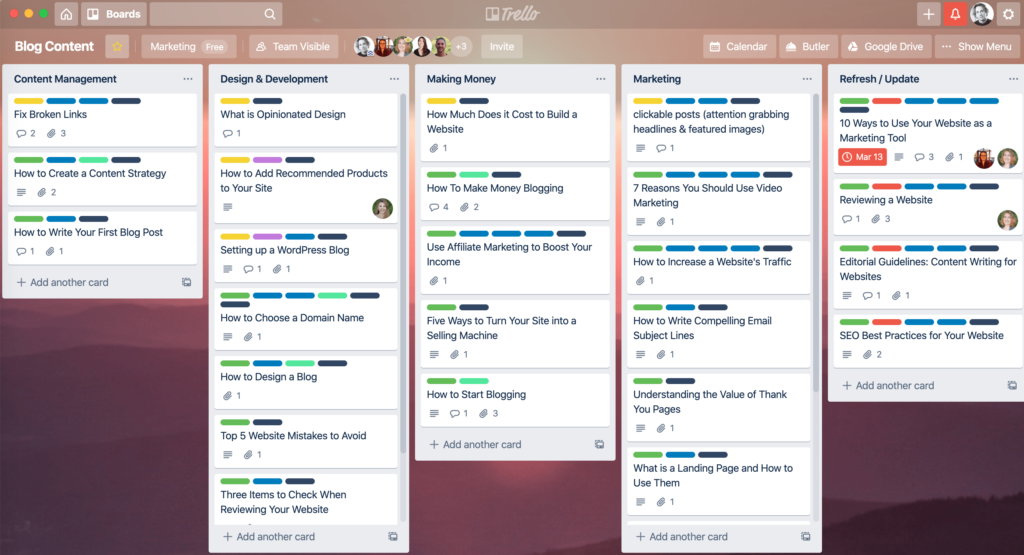As a content creator, you’ve probably got all these great new blog post ideas, but without a place to organize and track them, things can quickly become chaotic. This is why it’s helpful to have a content calendar so you can keep track of and schedule posts. Some people also refer to this as an editorial calendar (we’ll be using these terms interchangeably throughout this post).
Now, take an in-depth look at why a content calendar is worth the effort, the best marketing tools for planning your content, and how to organize your calendar in a way that works for you. Plus, stick around to the end where we share some free content calendar templates!
Why Do You Need a Content Calendar?
Simply put, a content calendar helps to organize and streamline your content creation process and publishing schedule. It defines what you’ll get done when and helps you stay on track.
You’re less likely to post content as often as you should if you don’t schedule it. You could also forget an amazing idea you had for a post or forget to make an important update to an old post if you don’t document that information. It also reminds you of what topics you’ve already covered on your blog so your content doesn’t get redundant.
We’ve talked to a lot of bloggers and small business owners, and one of the biggest struggles they have with their content is consistency—especially when they’re beginners.
So…how do you keep yourself organized and accountable when you’ve got so much else going on between your other job (if blogging is a side-hustle), home life, kids, spouse/partner, volunteer and other activities, time for fun (yeah, right!), and everything else?
A content calendar helps to keep you consistent in your content pieces and where you share them (either on your site or across different social media platforms).
If you have a team as opposed to doing everything yourself, a calendar is also a good way to communicate with each other. It also shows everyone who’s working on what and when their deadlines are so they can get everything done in a timely manner.
Bottom line, content management becomes easier by adding a content calendar to your digital marketing strategy.
How to Organize Your Content Calendar
This answer depends on several factors including the size of your team, your marketing goals, and how you work most efficiently. If you’re unsure right now, then try a variety of different content calendar tools. They can range from:
- Physical calendar: This can be a paper calendar that you hang on a wall, a whiteboard, or a book planner. This is only an option if you’re working alone as you can’t easily share or collaborate this way. Download this Pretty Darn Cute printable calendar, if this is your jam.
- Google Calendar: You can keep track of your content through your Google account across all of your devices, desktops, and phones. It’s also easy to share files with your content team through Google and organize everything into a Team Drive (if you have Google Apps for Work).
- Google Sheets or Excel spreadsheet: A spreadsheet is a simple, free option if you’re working solo or with a small group. It’s good for collaboration, but it can get hard to manage if you have a lot going on in your content marketing strategy or if your team grows.
- A project management tool: Trello, Asana, Basecamp, and CoSchedule are some of the more well known options. They’re convenient task management tools for teams and clients so that everybody can stay on the same page when working on and scheduling content. Plus, they have drag and drop functionality and calendar views/integrations.
Find a System that Works for You
We love Trello for managing our blog content calendar, but it took us a while to find the best way for our team to manage content.

We have used Basecamp for years to manage client projects, and it works great for that. But as we began to think more about content and ramp up our content production, we struggled to put a systematic workflow in place with Basecamp. It felt too hard to get a holistic view of everything we had going on.
Then, I attended a webinar on content strategy and the host mentioned Trello. She also shared a content strategy Trello board with all of us attendees. I was intrigued and began to play around with the tool. I started with a board for some specific content planning—a guide called, How to Start Blogging.
I realized very quickly that this is what I had been looking for. I was able to create a workflow and move things around so it was clear at what stage in our editorial process content was and what still needed to be done.
We kept refining, building on what we had, and even templatizing for our professional services clients.
We’ve settled on a design that works great for us. It includes ideas, category organization, search data and performance metrics, and status (i.e. Live, WIP).
Our calendar also includes our editorial workflow:
- 1st Draft
- Optimization (key terms & other updates)
- On-Page SEO
- Images Optimization (mainly sizing and Pinterest)
- Publish & Tracking
You could also integrate your social media post planning into your content calendar, but depending on how active you are, it may make more sense to use a dedicated social media management tool with built-in scheduling capabilities.
How to Structure Your Content Calendar
Again, this depends on you and what type of content you produce. However, there are a few key elements that every content calendar should have. The three basic categories of any good calendar are editorial, promotional, and future ideas.
The editorial section is where you’ll organize the content that you plan on publishing. The idea of the content calendar is to schedule what you plan on posting far in advance. This goes for your site, but it’s important for social media marketing too. You want to schedule your blog content and social media content in advance so that you have enough time for everything.
Some companies have 6 months to an entire year planned out, but it’s okay if you only plan for three weeks to a month ahead of time. You have to research, write, optimize, and pass content between team members before a deadline. This process goes a lot smoother when nobody is blindsided by not knowing what the new content is or when it should be produced.
The promotional section is where you organize how and when you’re going to promote your content. This doubles as your social media calendar since this is where you would plan out your social posts. Promotion extends past social media too though. You could market your content through email, a podcast, or a public speaking event too. Either way, it should be organized into one place so that you can keep tabs on it all.
The future ideas section is self-explanatory. This is where you would organize all of your brainstorming ideas for quality content that you want to do at an unspecified date. You don’t put these ideas into the editorial section because you don’t want to get distracted from content that’s more fleshed out to be posted sooner.
4 Steps to Create Your Calendar
Answer these four basic questions to create a content calendar that actually makes your life easier.
1. Where (do you create it)
Try out different tools, apps, and methods until you find something that works for you. It may be a physical calendar or even a notebook. Just because others are using fancy content management tools, doesn’t mean you have to!
Remember, your considerations may be different if you have a team and multiple people need access and a way to give input.
2. What (goes in it)
Make a list. Get all of your ideas for new content together.
It doesn’t matter how thought out each content idea is, you can put them in order later, just write them all down to get your calendar started. Later you can flesh them out more by adding things like search data, title ideas, and additional notes.
3. When (are tasks getting done)
Make a content schedule. Your entire marketing strategy should be pretty much laid out on your calendar. This goes for all pieces of content, including blog posts, social media posts, podcasts, emails, webinars, case studies, infographics, videos, and anything else in your content strategy.
You can also include important dates for other to-dos like content updates, site audits, team meetings, public appearances, affiliate marketing, marketing campaigns, and guest promotion work.
4. How (are tasks getting done)
Organize content and define your workflow. Color-code or label all of the different types of content so that it’s easy to understand. For example, you may want to distinguish your evergreen content from trendy news pieces, or, you can use labels to denote status or priority, etc.
Assign an owner to each piece of content. This way all members of your marketing team know what they’re responsible for so that everyone is on the same page.
A Well-Planned Content Calendar Makes a HUGE Difference
I truly feel that having a content calendar has made a world of difference for us. We are much more focused in what content we produce, and we execute much faster.
That’s not to say you should sacrifice quality for a higher posting frequency. We’d never advocate that. Having a plan, process, and schedule actually helps you create better content. It has also boosted our productivity, efficiency, communication, and planning.
Just take a look at our blog posting history if you need more proof. From April 2017–February 2019 we posted 17 blog posts. That’s a time period of 1 year and 10 months. Let’s round that to 9 posts a year to make things simpler.
Obviously we are not super proud of that output, but I am giving you the numbers to illustrate an important point. Once we committed to focusing on our blog content and put a repeatable process in place, our output soared (and so have our Google rankings by the way).
From the end of August 2019–today (about 6 1/2 months), we’ve published 14 blog posts and 1 guide on How to Start Blogging. At that rate, we’ll be at ~30 posts by the end of the year. So we have approximately tripled our output!
It’s not hard, it just takes some planning and commitment. With a process to fall back on, blogging consistently becomes a habit, and habits are awesome for productivity. In fact, a book we love and reference a lot here at BizBudding is Atomic Habits by James Clear (aff. link).
Content Calendar Templates
Figuring out a process and schedule for all your content can feel like an overwhelming task. Trust me, I get it. A content calendar template is great because it gives you a place to start, and then you can customize it to fit your needs.
That’s why we want to share a two types of free templates that you can choose from based on how you like to work. The Trello template is based on the actual content calendar we use, so obviously it is seriously cool.
In all seriousness, we think you may find it really useful. There are explainer cards throughout, so it’s clear what the purpose is of everything in there.
And remember how I mentioned the epicness of checklists earlier? Well, they’re in there too so you have a well-defined set of steps to follow at each stage in your editorial workflow.
There are checklists for:
- New Content Ideas
- 1st Draft
- Optimization
- Review
- On-page SEO
- Image Optimization
- Publish & Tracking
If spreadsheets are more your thing, we’ve got that for you too! We modeled a Google Sheets template off of one of our clients’ content calendars that we thought was really well laid out.
Sign up below to get the content calendar templates.

Get Our Free Content Calendar Templates
Fill out this quick form, and check your inbox for the templates.
As a bonus, we’ll also send you some additional tips on using these content calendars.
We promise not to send you anything lame, just useful info that we believe will help. If you want to bail after that, no hard feelings. 😉
Drop your name and email below get the templates.
Yes, it’s free!

